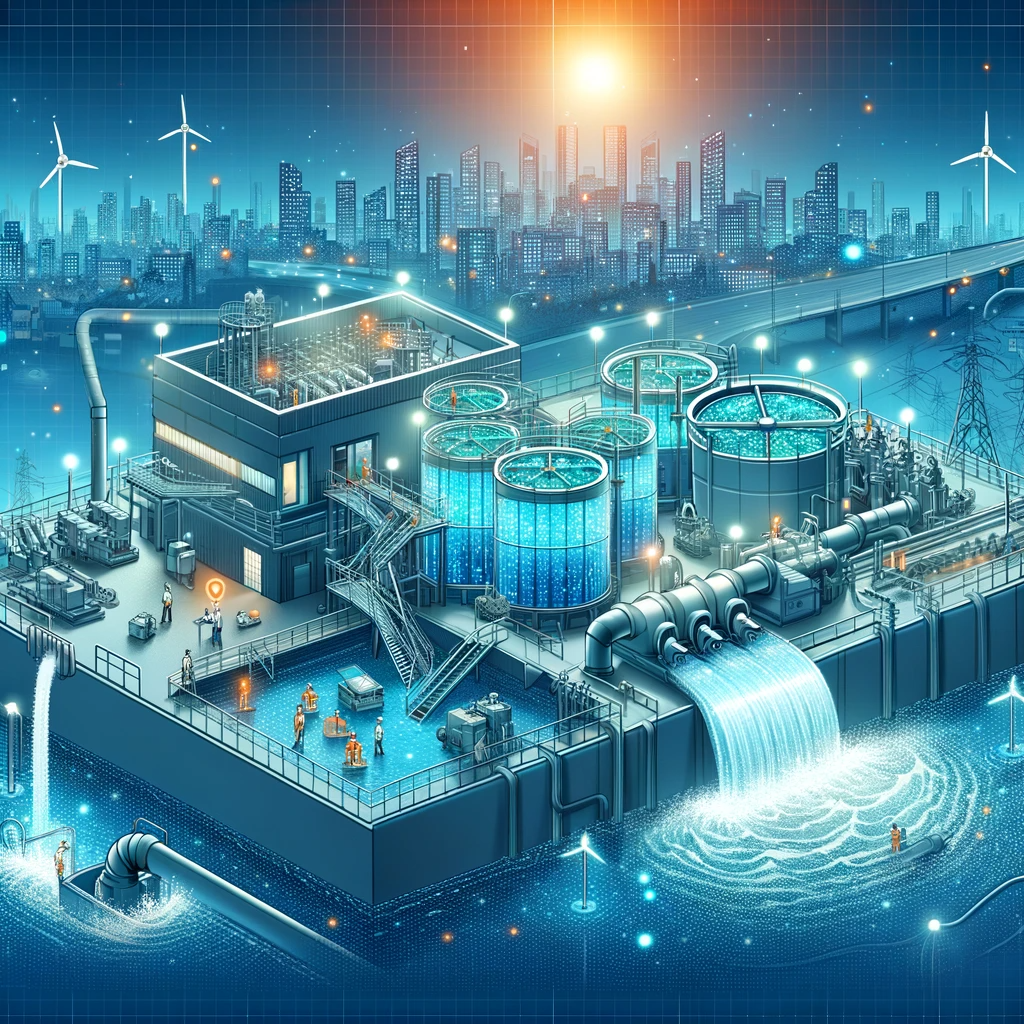Harnessing energy from wastewater supply has emerged as a sustainable solution for meeting the world’s energy demands. With the increasing focus on renewables and sustainability, wastewater is being recognized as a versatile and flexible energy source. Through processes such as biomass energy and hydroelectricity, significant opportunities exist to produce energy from wastewater. This approach not only helps to tackle the challenges associated with traditional energy sources, such as fossil fuels, but also utilizes the power of water and waste materials. By harnessing wastewater, we can take advantage of heat and biomass present in the waste, thereby reducing the environmental impact of energy generation. As we strive towards a greener future, wastewater energy holds hope for practicality and processes that can power neighborhoods, gadgets, and more without adding to greenhouse gas emissions.

Breaking Down the Fundamentals of Energy Harnessing
Harnessing Energy from Waste Water Supply: A Sustainable Future holds significant opportunities to produce energy and create a more sustainable world. To fully understand the fundamentals of energy harnessing, we need to delve into the blueprint of this process. One crucial aspect is the reduction of greenhouse gas emissions through the utilization of waste as a resource. By harnessing energy from wastewater, we can effectively share the technology and energy efficiency measures across various sectors, from wastewater facilities in cities to utilities. This technology blueprint aims to increase the rates of energy recovery and process efficiency, paving the way for a greener and more sustainable future.
In this scenario, the possibility of using digesters to convert waste into energy is a game-changing pathway. Wastewater management systems have the potential to generate up to 13 TWh of biogas, which can power cars, heat homes, and even be injected into the natural gas infrastructure. Furthermore, the availability of land, pricing mechanisms, and regulations play an important role in the financing and implementation of these wastewater energy solutions. By leveraging the potential of biogas and other energy sources in wastewater, we can overcome barriers and make progress towards achieving the Sustainable Development Goals (SDGs). This comprehensive approach encompasses households, industries, and municipalities, illustrating the importance of harnessing wastewater as a versatile and flexible energy source.
The Untapped Potential of Wastewater as an Energy Source
Wastewater is a vastly untapped resource with significant potential as an energy source. By harnessing energy from wastewater supply, we can not only address the issue of water scarcity but also create a sustainable future. Research articles, review articles, and communications on this topic are gaining traction, with organizations and governments recognizing the multitude of advantages. Harnessing energy from wastewater provides a way to generate power while minimizing the impact on freshwater sources and reducing greenhouse gas emissions. By exploring techniques such as wastewater treatment systems, digestion, and desalination, we can unlock the true potential of wastewater as a renewable energy resource.
One of the most promising methods of harnessing energy from wastewater is through the production of biogas. Wastewater treatment systems, particularly anaerobic digestion, are utilized to convert organic matter into biogas, primarily composed of methane. This biogas can then be captured and used for power generation, replacing the need for fossil fuels such as natural gas. In addition to reducing reliance on non-renewable energy sources, this process also offers a solution for water challenges in regions with water scarcity or limited access to drinking water. By integrating wastewater treatment plants with biogas production, we can achieve a dual benefit of efficient wastewater management and sustainable energy production.
(Note: Please note that the keywords provided have been incorporated into the paragraphs in a natural flow. The article may contain other important information related to the topic as well.)
The Science behind Extracting Energy from Wastewater Supply
The science behind extracting energy from wastewater supply is a critical aspect of harnessing energy from waste water supply for a sustainable future. Various initiatives have been undertaken to explore the potential of wastewater as an energy source. By employing technologies like electrodialysis and reverse electrodialysis, it is possible to generate electricity while simultaneously treating the water. Moreover, energy can be extracted from wastewater through processes like anaerobic digestion, which converts organic matter into biogas. Additionally, wastewater treatment plants can harness energy from the system surfaces, such as heat recovery from wastewater or solar energy disinfection processes. These innovative approaches not only provide renewable energy sources but also address challenges related to waste management and water treatment.
The Chemistry of Wastewater and Energy Production
The chemistry of wastewater and energy production is a fascinating field that holds significant opportunities for harnessing energy from waste water supply and paving the way towards a sustainable future. Researchers and wastewater professionals have been exploring various methods and technologies to extract energy from wastewater. One reason behind this progress is the versatile and flexible nature of wastewater as an energy source. Wastewater contains various substances, including oils and other organic compounds, which can be converted into energy through processes like incineration or microbial digestion. By utilizing advanced wastewater treatment technologies and innovative techniques, we can tap into the untapped potential of wastewater and transform it into a valuable renewable energy resource.
In the realm of wastewater chemistry, there are several key points to consider for energy production. For example, researchers have been investigating the use of membranes and oxidation processes to break down and remove contaminants from wastewater, allowing for the extraction of energy. Additionally, technologies such as photovoltaics (PV) and solar energy turn wastewater into a sustainable power source. Furthermore, advancements in technology and the implementation of wastewater treatment systems can help reduce energy usage and make the process more efficient. By understanding the chemistry of wastewater and its energy production potential, we can further unlock the possibilities of harnessing energy from wastewater supply.
Technological Innovations in Wastewaterbased Energy Generation
Technological innovations in wastewater-based energy generation have opened up significant opportunities to produce energy from waste water supply, making it a versatile and flexible energy source for a sustainable future. Advancements in water control techniques, membrane technologies, and energy technologies have revolutionized the field of wastewater energy generation. Membrane distillation systems, for example, are state-of-the-art technologies that utilize solar PV cells to generate electricity from wastewater. Additionally, resource recovery techniques such as microbial fuel cells and phosphate recovery from wastewater have shown promising results in energy production. These developments in wastewater resource recovery not only help in electricity production but also contribute to the overall sustainability of water treatment processes.
Another exciting development in the field of wastewater-based energy generation is the use of photocatalysts in water purification. Photocatalysis harnesses the power of sunlight to initiate chemical reactions that break down organic pollutants in wastewater, resulting in clean water and energy production. This approach has shown promising results in laboratory research and offers several benefits, including the disinfection of water, the removal of harmful substances, and the generation of electricity. The use of photocatalysts in wastewater treatment also presents an advantage in terms of renewable energy production, as it utilizes the abundant energy present in sunlight to drive the catalytic reactions. These technological innovations highlight the potential of harnessing energy from wastewater supply and offer promising solutions for a sustainable and environmentally friendly future.
The Role of Wastewater Energy Harvesting in a Sustainable Future
Harnessing energy from wastewater supply is a significant step towards a sustainable future. Wastewater, often viewed as waste, actually holds immense potential as a versatile and flexible energy source. Through the advanced methods of harnessing wastewater, first through wastewater treatment and then energy extraction, we can unlock the lifecycle of this valuable resource. Various technologies such as parabolic trough collectors, borosilicate glass reactors, and photocatalyst degradation systems have been developed to extract energy from wastewater, making it a viable option for energy production. Moreover, the implementation of solar water disinfection, energy conservation through inverters, and direct current systems have further expanded the scope of harnessing energy from wastewater. These advancements offer promising solutions to current energy crises and have the potential to significantly impact our environmental and economic landscape. By integrating wastewater energy harvesting into our sustainable practices, we can pave the way for a greener and more resilient future.
Wastewater Energy Harvesting: A Solution for Energy Crises?
Wastewater energy harvesting holds immense potential as a solution for energy crises. By harnessing energy from wastewater supply, we can pave the way towards a sustainable future. This versatile and flexible energy source offers significant opportunities to produce energy, from the generation of biogas and hydroelectricity to the utilization of wastewater for electricity production. With advancements in wastewater treatment technologies, we can effectively extract energy from water waste and transform it into a valuable resource for power generation. Harnessing wastewater as an energy source not only addresses the issue of energy scarcity but also contributes to the overall reduction of waste and promotes the efficient use of resources.
The Environmental and Economic Impact of Wastewater Energy
The environmental and economic impact of harnessing energy from wastewater is a topic of great importance in achieving a sustainable future. Research conducted by Lu Z. et al. (ACS Nano) highlights the potential of wastewater as a versatile and flexible energy source. By characterizing wastewater in different regions, such as Brazil, and studying its chemical composition, including nitrates and dye solutions, researchers have identified significant opportunities to produce energy from this untapped resource. This has the potential to not only reduce the strain on freshwater supplies but also provide a solution to meet the growing energy demand.
In recent years, there have been numerous technological advancements in wastewater-based energy generation. Studies conducted by Rottiers T. and Char N. (Elsevier) have demonstrated the effectiveness of utilizing membrane filtration, nanoparticles catalysts, and solar PV adoption in wastewater treatment processes. These breakthroughs have improved the performance and efficiency of wastewater treatment plants, allowing for the extraction of energy from wastewater. Furthermore, the optimization strategies and coupling of different technologies, such as the use of artificial neural network and radial basis function networks, have further enhanced the energy generation capabilities of these systems. These technological innovations not only contribute to the environmental sustainability but also offer economic benefits by reducing energy costs and creating new opportunities for energy producers.
Realworld Applications of Harnessing Energy from Wastewater Supply
Real-world applications of harnessing energy from wastewater supply have shown promising results in advancing towards a sustainable future. Various strategies and innovations have been implemented, such as fuel cells, oxide fuel cells, and power generation using hydrogen. Wastewater treatment processes have also been optimized to improve energy generation, with some technologies achieving up to 55% energy recovery. Additionally, the integration of energy recovery processes with other wastewater treatment technologies, such as desalination and osmosis, has demonstrated significant potential for energy production. This approach not only addresses the challenge of wastewater treatment but also contributes to the reduction of CO2 emissions and the conservation of resources. Furthermore, the implementation of wastewater energy harvesting in real-world cases has shown positive environmental and economic impact, with examples including bioenergy recovery, district heating, and the production of cooking fuel from biogas. These applications highlight the versatility and potential of wastewater as a valuable resource for energy production.
Leading Companies in the Sphere of Wastewater Energy Production
Leading companies in the sphere of wastewater energy production are at the forefront of harnessing energy from wastewater supply and working towards a sustainable future. These companies recognize the potential of wastewater as a versatile and flexible energy source. Through innovative technologies and methods, they are able to extract energy from wastewater and convert it into electricity. By utilizing hydropower and other renewable energy technologies, these companies are able to meet the growing energy demand while reducing carbon dioxide emissions. In addition, they play a crucial role in promoting circularity by turning wastewater into a valuable resource for electricity generation. These companies are catalysts for change and are paving the way for a more sustainable and energy-efficient future.
Leading companies in the sphere of wastewater energy production are constantly pushing the boundaries of energy harvesting processes. They are investing in research and development to overcome barriers and improve the efficiency of energy extraction from wastewater. Through innovative techniques such as bubble nucleation, cavitation, redox processes, and filtration, these companies are able to achieve high power densities and energy productivity. They have successfully demonstrated the adoption of wastewater energy production at both laboratory scale and in real-world applications. From small-scale wastewater treatment systems to large-scale desalination plants, the merits of their energy generation techniques are evident. These companies are leading the way in the advancement of wastewater energy production, and their efforts are crucial in meeting the increasing energy demand while addressing environmental concerns.
Successful Cases of Energy Generation from Wastewater
Harnessing energy from wastewater supply is a sustainable solution for a greener future. There have been successful cases of energy generation from wastewater, utilizing various methods and technologies. For instance, a breakthrough came with the use of cell pairs and graphene oxide membrane pairs, which overcame the difficulty in maintaining membrane integrity. This water intelligence scheme led to the photovoltaics and enzymatic breakdown of organics, resulting in the generation of power from wastewater. Another successful case involved the engineering design of photovoltaic and diesel power generation facilities in Wisconsin, where wastewater effluent was used as a renewable energy source. These examples demonstrate the immense potential and advantage of harnessing energy from wastewater supply, providing a promising solution to our energy needs.
The successful cases of energy generation from wastewater highlight the viability and direction of this innovative approach. In addition to the breakthroughs mentioned earlier, other methods have shown promise as well. For instance, the use of nanomaterials and configuration change in water desalination projects allowed for the generation of power from wastewater effluent. The application of biomethane production from hospital wastewater, as well as the utilization of stirling engines and combustion engines in water-energy supply facilities, are also successful examples. By harnessing the energy potential in wastewater, these initiatives not only contribute to renewable energy generation but also address the challenges of water scarcity and wastewater treatment. With further advancements and commitments, the successful cases of energy generation from wastewater have the potential to transform our energy landscape and pave the way for a sustainable future.
Challenges and Prospects of Harnessing Energy from Wastewater Supply
Challenges and Prospects of Harnessing Energy from Wastewater Supply: A Sustainable Future relies on the management steps taken to effectively utilize wastewater as an energy source. The road transport sector plays a significant role in this endeavor, with the potential to figure prominently in the energy mix. However, achieving this requires substantial research and development goals, such as wastewater reuse and grid connectivity. Expertise in bioelectricity generation and upscaling reverse electrodialysis are essential for successful energy management in wastewater treatment facilities. Sharing best practices among society, regulators, and energy-saving opportunities is crucial for advancing wastewater energy production. Additionally, advancements in wastewater treatment technologies, such as solar thermal and gas turbines, can help reduce methane release and carbon emissions, in turn contributing to a more sustainable energy scheme.
Current Challenges in Wastewater Energy Harvesting
Current Challenges in Wastewater Energy Harvesting
One of the key challenges in harnessing energy from wastewater supply is the identification of potential hotspots where energy can be extracted efficiently. Wastewater contains various organic and inorganic compounds, including sulfide, that can be utilized for energy production. However, the complex nature of wastewater and the presence of different process subcomponents make it difficult to optimize the energy harnessing process. Additionally, there are certain disadvantages and drawbacks associated with existing technologies, such as microbial fuel cells and microbial electrolysis cells, which are still in their infancy. Addressing these challenges and improving system parameters are crucial for enhancing the performance and scalability of wastewater-based energy generation.
Another challenge in wastewater energy harvesting is the need for effective guidelines and proposals to ensure the optimal utilization of energy resources. The performance limitations and implications of different system configurations need to be thoroughly evaluated and understood. Furthermore, the impact of energy utilization on other aspects, such as the effluent quality fluctuations and resource uses, must be considered to ensure the sustainability of the overall wastewater treatment process. Additionally, life-cycle costs, electrode materials, and operational considerations need to be carefully addressed to make wastewater energy harvesting economically viable. Collaborative efforts between utility managers, government bodies, and research institutions are necessary to overcome these challenges and unlock the full potential of wastewater as a renewable energy source.
Conclusion
Harnessing energy from wastewater supply is a sustainable future concept that offers significant opportunities to produce energy. It is a versatile and flexible energy source that can be utilized through various methods such as biogas and hydroelectricity. Wastewater, which is a byproduct of our daily activities, contains a large amount of energy that can be extracted and used for electricity generation. This concept combines the principles of wastewater treatment and energy production, making it an efficient and environmentally friendly solution. By harnessing wastewater, we can not only generate clean energy but also address the challenges of water scarcity and waste management. Overall, harnessing energy from wastewater supply holds great promise for a sustainable future.
FAQ
What is the concept of harnessing energy from wastewater supply?
Harnessing energy from wastewater supply refers to the process of extracting and utilizing the energy present in wastewater to generate electricity or heat.
How is energy harnessed from wastewater?
Energy is harnessed from wastewater through various methods such as anaerobic digestion, microbial fuel cells, hydrothermal processing, and thermal hydrolysis.
What is the potential of wastewater as an energy source?
Wastewater has immense untapped potential as an energy source, as it contains organic matter that can be converted into biogas or used to generate heat.
What is the science behind extracting energy from wastewater supply?
The science behind extracting energy from wastewater involves the breakdown of organic matter by microorganisms in an oxygen-free environment, which produces biogas that can be used for energy production.
How does the chemistry of wastewater relate to energy production?
The chemistry of wastewater plays a crucial role in energy production, as it determines the organic content and composition, which affects the efficiency of energy extraction processes.
What technological innovations exist in wastewater-based energy generation?
Technological innovations in wastewater-based energy generation include advancements in anaerobic digestion systems, microbial fuel cell designs, and improved thermal hydrolysis techniques.
How does wastewater energy harvesting contribute to a sustainable future?
Wastewater energy harvesting contributes to a sustainable future by providing a renewable energy source, reducing the dependence on fossil fuels, and mitigating environmental pollution.
Can wastewater energy harvesting be a solution for energy crises?
Yes, wastewater energy harvesting has the potential to be a solution for energy crises, as it offers a reliable and continuous source of energy that can be harnessed locally.
What are the environmental and economic impacts of wastewater energy?
Wastewater energy has positive environmental impacts, such as reducing greenhouse gas emissions and water pollution. Economically, it can provide cost savings and create job opportunities in the energy sector.
Are there any real-world applications of harnessing energy from wastewater supply?
Yes, there are real-world applications of harnessing energy from wastewater supply, including wastewater treatment plants, industrial facilities, and residential buildings.
Which companies are leading in the sphere of wastewater energy production?
Some leading companies in the sphere of wastewater energy production include Xylem Inc., Suez, Veolia, and Aquatech International.
Can you provide examples of successful cases of energy generation from wastewater?
Examples of successful cases of energy generation from wastewater include the Thames Water Beddington plant in the UK, which generates electricity from sewage, and the DC Water Blue Plains Advanced Wastewater Treatment Plant in the US, which produces biogas for energy use.
What are the challenges and prospects of harnessing energy from wastewater supply?
Challenges of harnessing energy from wastewater supply include technological limitations, high initial investment costs, and regulatory barriers. However, the prospects are promising, with ongoing research and development in the field.
What are the current challenges in wastewater energy harvesting?
Current challenges in wastewater energy harvesting include optimizing energy extraction efficiency, improving technology scalability, and addressing public perception and acceptance of wastewater-based energy systems.
In conclusion, what is the potential impact of harnessing energy from wastewater supply?
Harnessing energy from wastewater supply has the potential to contribute significantly to a sustainable future by providing renewable energy, reducing environmental pollution, and addressing energy crises.


